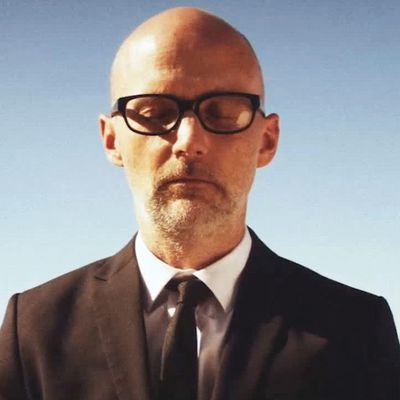
At one point in his new documentary, the pioneering electronic musician Moby strums a banjo and sings to the camera, “I know that we’ve been in a fairly conventional narrative for a little while, but now, we’re gonna go back to being weird.” Weird is … perhaps the most fitting descriptor for Moby Doc, which finds the musician reflecting on his rise to fame and personal struggles with alcohol and drug abuse.
Moby, who is known for making outlandish statements, previously released a memoir full of celebrity encounters in 2019 (the book’s promotions were quickly cut short after Natalie Portman disputed his claim that they dated). His latest attempt to chronicle his life takes advantage of the medium of video in several strange, fascinating, and occasionally (quite literally) morbid ways. From having friends act out his childhood trauma to taking a walk with the personification of death, here are 11 of the oddest moments in Moby’s “surrealist” film:
The “Childhood Trauma Re-enactment Players”
To explain what his life was like growing up, Moby recruits some friends to perform a scene in which Moby, at around three years of age, is left alone at home. Singer-songwriter Laura Dawn and actor Daniel Ahearn play his mom and her “scumbag” boyfriend, as Moby dons a red beret and directs them to care less. Meanwhile, he tells Daron Murphy, the fully grown man portraying young Moby, to show some more sadness.
The Recurring Rats
According to Moby, his family’s many pets taught him that people are terrifying but animals are nice. In particular, he connected with lab rats that his dad brought home from a job in Columbia’s chemistry department. For some reason, the rats are initially drawn as chihuahuas in an animation sequence. But they reappear later in the doc as rat puppets that offer occasional commentary. During the end credits, they harmonize a cover of Moby’s song “The Perfect Life.”
That Poop Story …
After introducing himself as Dr. Richard, Moby poses near a white board with the words MEDICAL SCIENCE written on it. He explains that he wants to talk about alcoholism and launches into a story about an experience he had on a tour bus while headed from London to Manchester. Under the influence of 15 or 20 drinks and a “whole bunch” of drugs, he recalls having a sexual encounter with a few different people and waking up covered in poop. “To this day, I don’t know whose poop it was,” he says. The word ALCOHOLIC appears on the whiteboard along with a large arrow pointing to him. Moby smiles and flashes a thumbs-up.
His “Therapist”
Several times throughout the documentary, we see Moby sitting across from a woman in glasses (his muse, Julie Mintz). Over strangely ominous background sounds, she asks him to talk about his feelings. But her expressions don’t seem fully genuine as she takes notes — at one point, she yawns. Her final professional personal verdict is that Moby is a sad and broken human being. In response, he turns, looks directly at the viewer, and says, “You know what I’m talking about, right?”
An Animal-Mask Gathering
In this unexplained scene, Moby wears red robes and leads a group of people down the street while striking what appears to be a Tibetan singing bowl. Most of the people chanting around him are wearing white robes and animal masks that completely cover their faces. We see this group gather around him inside a building, where Moby yells out an imitation of the bowl’s tone. A red tint then washes over the room.
His Suicidal Thoughts, As Told to … a Dog
Moby recounts this sobering memory directly to a dog. He reveals that the night before the MTV Awards in 2002, he stayed in an apartment at the top of a Barcelona hotel right next door to Diddy, Bon Jovi, and Madonna. According to Moby, he was so drunk and distraught that the only reason he didn’t kill himself was because the windows didn’t open wide enough. Elsewhere in the documentary, Moby praises nature and other animals for not caring about humans. As he describes his suicidal thoughts, we get a reverse shot of the husky’s indifferent reaction.
A Visit to His Fake House
In college, Moby asked his friends to drop him off at the address of a really nice estate so that they would think he lived there. He says he felt like an “11th-class citizen” because he was so much poorer than other people in the town. For this documentary, he returns to stand outside the house. He tells the camera that he used to fantasize about living somewhere like it and having a golden retriever asleep at his feet while his beautiful wife wrote poetry by the windows.
A Jarring Description of His Former Real Home
At the start of his music career, Moby “squatted” with a few other artists in a Stamford, Connecticut, building that used to be a lock factory. For $50 a month, a security guard allowed him to stay in a place where he estimates that three people were murdered in two years. That includes a friend of his who, Moby remembers, was stabbed to death in the old factory. Moby follows this detail by cheerily saying that he loved living there because it had free electricity and was sunny.
“The Sleep of Reason”
This black-and-white sequence features Moby sitting at a table. Video overlaid on his face depicts an iceberg falling into the water. A flower blooms around Mintz’s head. The iceberg over his face reverses its course, coming out of the water. Mountains appear on the screen, and as the woman who played his therapist looks at him, the flower around her migrates over to him.
His Alien Counterpart
The cartoon alien with antennae from his Wait for Me album cover appears throughout the documentary. In one animated scene, Moby does a voice-over as the alien talks to a dog smoking a pipe. Later, we see a cartoon Earth pop like a balloon after it hits a star behind the alien. There’s plenty of extraterrestrial and space imagery associated with Moby, who has several shots throughout the documentary standing in a desert as the moon rushes toward him in the sky. When he finds a box with this alien drawn on it, he calls it “sort of a self portrait” and asks if it wants to go on a ride with him. He says that he, too, is from another planet.
His Conversation With Death
Short clips of a Grim Reaper–like figure are inserted throughout the documentary until finally, we see Moby meet up with Death in a forest. They walk side by side in front of a setting sun, as Moby says he is in some ways a fan of Death’s work. He explains that he is an animal-rights activist and that death ends the pain of factory farm animals who experience only sickness and suffering. Extending that logic to sick and suffering people, Moby reasons that Death is merciful. “I think it’s also a little strange that people are afraid of you and have such negative opinions about you because you’re the only, literally the only guarantee in people’s lives,” he adds.
This I’m-not-like-other-humans approach apparently works because Death decides to make an exception and tell Moby what happens after life ends. The documentary then rewinds through its scenes, all the way back to Moby’s childhood. Next we hear a thumping heartbeat, and the adult Moby opens his eyes in a room where different hues of ink are floating upward. Mintz is seated on the bed behind him and asks, “Has this helped?” Moby is cut off before he can get out a full response.





